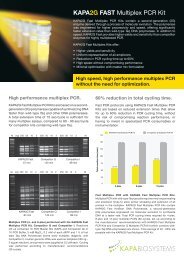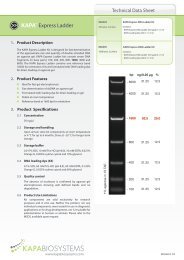KAPA PROBE FAST Eppendorf Multiplex qPCR ... - Kapa Biosystems
KAPA PROBE FAST Eppendorf Multiplex qPCR ... - Kapa Biosystems
KAPA PROBE FAST Eppendorf Multiplex qPCR ... - Kapa Biosystems
Create successful ePaper yourself
Turn your PDF publications into a flip-book with our unique Google optimized e-Paper software.
<strong>Multiplex</strong> Real-Time PCR<br />
Methods<br />
To demonstrate the ability to perform fast multiplex <strong>qPCR</strong><br />
without compromising reaction efficiencies, a set of eight 2-fold<br />
(Figure 1) or four 4-fold serial dilutions of human genomic DNA<br />
were amplified using either single (Figure 2) or duplex (Figure 3)<br />
assays and a fast cycling protocol (3 min at 95 °C initial activation,<br />
40 cycles of 3 sec at 95 °C and 20 sec at 60 °C). Amplification was<br />
performed in full-skirted <strong>Eppendorf</strong> ® Twin.tec plates with optical<br />
clear heat-sealing film using the realplex 4 S real-time PCR system.<br />
Two hydrolysis probe-based <strong>qPCR</strong> assays were used in this study<br />
(Table 1). Dye calibration for the Cal Fluor ® Gold 540 TaqMan ®<br />
assay was performed as described by Biosearch Technologies.<br />
The resulting log amplification plots and standard curves<br />
for each assay performed separately (Figure 2) and in duplex<br />
(Figure 3) indicate that neither the cycle threshold (C T ), nor the<br />
efficiency of the <strong>qPCR</strong> reactions were compromised as the result<br />
of the multiplex format. The differences in mean C T values (ΔC T )<br />
for each of the four 4-fold dilutions in both the single and duplex<br />
reactions indicate comparable performance between single and<br />
duplex reactions (Table 2). The fast protocol results in a time saving<br />
of 56 min relative to a conventional slow protocol (10 min at 95 °C<br />
initial activation, 40 cycles of 15 sec at 95 °C and 60 sec at 60 °C)<br />
when performed on the realplex 4 S real-time PCR system.<br />
Conclusion<br />
High-performance, multiplex <strong>qPCR</strong> requires a real-time<br />
instrument capable of sensitive multi-channel detection with<br />
excellent block uniformity and a <strong>qPCR</strong> reagent capable of<br />
maintaining high reaction efficiency of all amplicons in a multiplex<br />
format. The combination of <strong>Eppendorf</strong> ® Mastercycler ® ep realplex 4<br />
S real-time PCR system and <strong>KAPA</strong> <strong>PROBE</strong> <strong>FAST</strong> <strong>qPCR</strong> kits provides<br />
an industry-leading solution for high-performance, multiplex <strong>qPCR</strong><br />
without compromising reaction efficiency and reproducibility<br />
relative to single reactions.<br />
Table 1. Reaction parameters used in this study.<br />
Parameter ActB assay ERBB2 assay<br />
Amplicon length 123 bp 124 bp<br />
TaqMan ® fluorophores 5'-FAM / 3'-BHQ ® -1<br />
5'-CAL Fluor ® Gold<br />
540 / 3'-BHQ ® -1<br />
Primer concentration 200 nM each 200 nM each<br />
Probe concentration 50 nM 200 nM<br />
Excitation wavelength 470 nm 470 nm<br />
Emission wavelength 520 nm 550 nm<br />
For more information on the <strong>Eppendorf</strong> ® Mastercycler ® ep realplex 4<br />
S real-time PCR instrument or <strong>Kapa</strong> <strong>Biosystems</strong>' <strong>KAPA</strong> <strong>PROBE</strong><br />
<strong>FAST</strong> <strong>qPCR</strong> Kits please contact your respective local sales<br />
representative or visit:<br />
www.eppendorfna.com and www.kapabiosystems.com.<br />
Fluorescence (norm)<br />
10000<br />
1000<br />
100<br />
C t [Cycle]<br />
32<br />
30<br />
28<br />
26<br />
24<br />
22<br />
0.1 1.0 10 100<br />
Amount[ng]<br />
SLOPE Y-intercept Efficiency R 2<br />
FAM -3.266 28.87 1.02 0.998<br />
Application Note<br />
Table 2. Mean C T values for two targets, ActB and ERBB2, in single and duplex<br />
<strong>qPCR</strong>.<br />
1000<br />
10 32<br />
30<br />
28<br />
26<br />
24<br />
1<br />
0.1 0 1 2 3 4 5 1.0 6 7 8 9 10 1110 12 13 14 15 16 17 100 18 19202122232425262728293031323334353637383940<br />
SLOPE<br />
Amount[ng]<br />
Y-intercept Efficiency R<br />
Cycle<br />
100<br />
2<br />
ORANGE -3.404 29.59 0.97 1<br />
10<br />
C t [Cycle]<br />
1<br />
0 1 2 3 4 5 6 7 8 9 10 11 12 13 14 15 16 17 18 19202122232425262728293031323334353637383940<br />
Cycle<br />
Figure 2: Single <strong>qPCR</strong> reactions. Data showing log amplification plots of a set of four<br />
4-fold serial dilutions of hgDNA ranging from 40 – 0.625 ng per reaction using a fast<br />
2-step cycling protocol. Data represents four replicates for each DNA dilution. The<br />
ActB and ERBB2 assays are shown in green and orange, respectively.<br />
Fluorescence (norm)<br />
Conc. of<br />
human<br />
genomic<br />
DNA<br />
10000<br />
1000<br />
100<br />
10<br />
C t [Cycle]<br />
C t [Cycle]<br />
32<br />
30<br />
28<br />
26<br />
24<br />
22<br />
0.1 1.0 10 100<br />
Amount[ng]<br />
SLOPE Y-intercept Efficiency R 2<br />
FAM -3.223 28.91 1.04 0.997<br />
32<br />
30<br />
28<br />
26<br />
24<br />
22<br />
Duplex<br />
PCR<br />
0.1 1.0 10 100<br />
Amount[ng]<br />
SLOPE Y-intercept Efficiency R 2<br />
FAM -3.448 29.65 0.95 0.993<br />
ActB assay ERBB2 assay<br />
Single<br />
PCR<br />
ΔC T<br />
1<br />
0 1 2 3 4 5 6 7 8 9 10 11 12 13 14 15 16 17 18 19202122232425262728293031323334353637383940<br />
Figure 3: Duplex <strong>qPCR</strong> reactions. Data showing log amplification plots of a set of<br />
four 4-fold serial dilutions of hgDNA ranging from 40 – 0.625 ng per reaction using<br />
a fast 2-step cycling protocol. Data represents four replicates for each DNA dilution.<br />
The ActB and ERBB2 assays are shown in green and orange, respectively.<br />
Trademarks: Mastercycler ® (<strong>Eppendorf</strong> AG); TaqMan ® (Roche Group); Cal Fluor ® and BHQ ® -1<br />
(Biosearch Technologies); FAM (Applera Corporation).<br />
Cycle<br />
Duplex<br />
PCR<br />
Single<br />
PCR<br />
ΔC T<br />
40 ng 24.08 24.29 0.21 22.46 22.75 0.29<br />
10 ng 26.04 26.09 0.05 24.63 24.68 0.05<br />
2.5 ng 27.82 28.17 0.35 26.79 26.76 -0.03<br />
0.3125 ng 30.70 30.67 -0.03 29.58 29.54 -0.04










